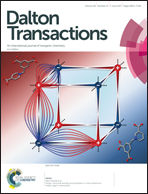Delocalized and localized donating–accepting Mn–C interactions in half-sandwich cyclopentadienyl and pentadienyl complexes†
Abstract
The widely used cyclopentadienyl (Cp) ligand and the pentadienyl (Pdl) ligand have very similar molecular orbitals (MOs) but they have significantly different chemical behavior. The extensively mixing of the MOs in the Pdl ligand has prevented a quantitative explanation of the observed differences between these two ligands. In a series of synthesized close/open half sandwich manganese phosphine carbonyls, the quantum theory of atoms in molecules and the interacting quantum atom model allow us to quantify the accepting–donating capacities of both ligands and to break down the M–dienyl bond into individual atomic interactions. The Mn–Pdl bond is stronger, more localized and has a larger backbonding contribution than the Mn–Cp bond. All carbon atoms in the Cp ring interact similarly with the Mn center, whereas the Pdl's terminal carbon atoms exhibit a strong donor and a moderate acceptor character, and C2 and C4 have an acceptor character and C3 a donor character. Contrarily to the constrained five-membered Cp ring, the stronger Mn–Pdl interaction can barely compensate for the large destabilizing distortion of the backbone of the nonaromatic Pdl ligand.



 Please wait while we load your content...
Please wait while we load your content...